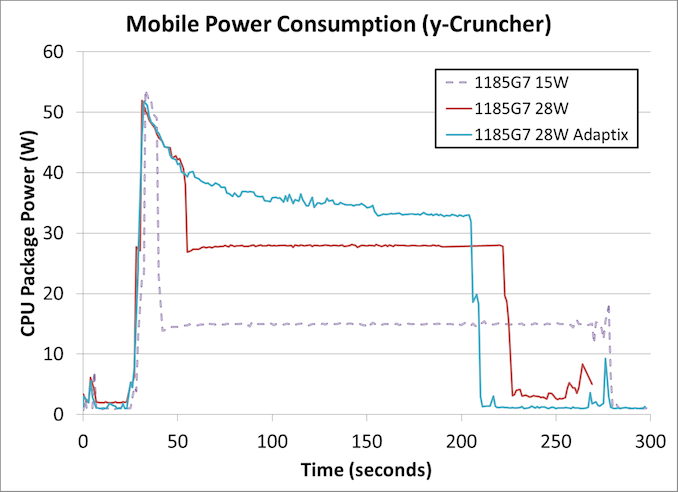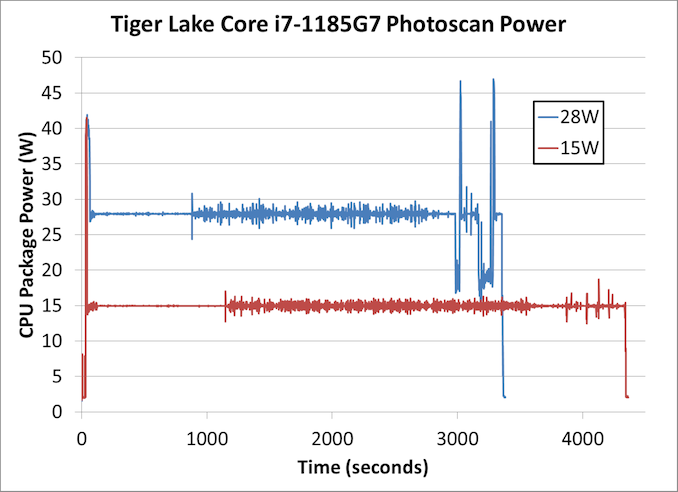Intel’s Tiger Lake 11th Gen Core i7-1185G7 Review and Deep Dive: Baskin’ for the Exotic
by Dr. Ian Cutress & Andrei Frumusanu on September 17, 2020 9:35 AM EST- Posted in
- CPUs
- Intel
- 10nm
- Tiger Lake
- Xe-LP
- Willow Cove
- SuperFin
- 11th Gen
- i7-1185G7
- Tiger King
Comparing Power Consumption: TGL to TGL
On the first page of this review, I covered that our Tiger Lake Reference Design offered three different power modes so that Intel’s customers could get an idea of performance they could expect to see if they built for the different sustained TDP options. The three modes offered to us were:
- 15 W TDP (Base 1.8 GHz), no Adaptix
- 28 W TDP (Base 3.0 GHz), no Adaptix
- 28 W TDP (Base 3.0 GHz), Adaptix Enabled
Intel’s Adaptix is a suite of technologies that includes Dynamic Tuning 2.0, which implements DVFS feedback loops on top of supposedly AI-trained algorithms to help the system deliver power to the parts of the processor that need it most, such as CPU, GPU, interconnect, or accelerators. In reality, what we mostly see is that it reduces frequency in line with memory access stalls, keeping utilization high but reducing power, prolonging turbo modes.
Compute Workload
When we put these three modes onto a workload with a mix of heavy AVX-512 compute and memory accesses, the following is observed.
Note that due to time constraints this is the only test we ran with Adaptix enabled.
This is a fixed workload to calculate 2.5 billion digits of Pi, which takes around 170-250 seconds, and uses both AVX-512 and 11.2 GB of DRAM to execute. We can already draw conclusions.
In all three power modes, the turbo mode power limit (PL2) is approximately the same at around 52 watts. As the system continues with turbo mode, the power consumed is decreased until the power budget is used up, and the 28 W mode has just over double the power budget of the 15 W mode.
Adaptix clearly works best like this, and although it initially follows the same downward trend as the regular 28 W mode, it levels out without hitting much of a ‘base’ frequency at all. Around about the 150 second mark (120 seconds into the test), there is a big enough drop followed by a flat-line which would probably indicate a thermally-derived sustained power mode, which occurs at 33 watts.
The overall time to complete this test was:
- Core i7-1185G7 at 15 W: 243 seconds
- Core i7-1185G7 at 28 W: 191 seconds
- Core i7-1185G7 at 28 W Adaptix: 174 seconds
In this case moving from 15 W to 28 W gives a 27% speed-up, while Adaptix is a total 40% speed-up.
However, this extra speed does come at the cost of total power consumed. With most processors, the peak efficiency point is when the system is at idle, and while these processors do have a good range of high efficiency, when the peak frequencies are requested then we are in a worst case scenario. Because this benchmark measures power over time, we can integrate to get total benchmark power consumed:
- Core i7-1185G7 at 15 W: 4082 joules
- Core i7-1185G7 at 28 W: 6158 joules
- Core i7-1185G7 at 28 W Adaptix: 6718 joules
This means that for the extra 27% performance, an extra 51% power is used. For Adaptix, that 40% extra performance means 65% more power. This is the trade off with the faster processors, and this is why battery management in mobile systems is so important - if a task is lower priority and can be run in the background, then that is the best way to do it to conserve battery power. This means things like email retrieval, or server synchronization, or thumbnail generation. However, because users demand the start menu to pop up IMMEDIATELY, then user-experience events are always put to the max and then the system goes quickly to idle.
Professional ISV Workload
In our second test, we put our power monitoring tools on Agisoft’s Photoscan. This test is somewhat of a compute test, split into four algorithms, however some sections are more scalable than others. Normally in this test we would see some sections rely on single threaded performance, while other sections use AVX2.
This is a longer test, and so the immediate turbo is less of a leading factor across the whole benchmark. For the first section the system seems content to sit at the respective TDPs, but the second section shows a more variable up and down as power budget is momentarily gained and then used up immediately.
Doing the same maths as before,
- At 15 W, the benchmark took 4311 seconds and consumed 64854 joules
- At 28 W, the benchmark took 3330 seconds and consumed 92508 joules
For a benchmark that takes about an hour, a +30% performance uplift is quite considerable, however it comes at the expense of +43% power. This is a better ratio than the first compute workload, but still showcases that 28 W is further away from Tiger Lake’s ideal efficiency point.
Note that the power-over-time graph we get for Agisoft on a mobile processor looks very different to that of a desktop processor, as a mobile processor core can go above the TDP budget with fewer threads.
This leads to the dichotomy of mobile use cases with respect to the marketing that goes on for these products - as part of the Tiger Lake launch, Intel was promoting its use for streaming, professional workflows such as Adobe, video editing and content creation, and AI acceleration. All of these are high-performance workloads, compared to web browsing or basic office work. Partly because Tiger Lake is built on the latest process technology, as well as offering Intel’s best performing CPU and GPU cores, the product is going to be pitched in the premium device market for the professionals and prosumers that can take advantage.












253 Comments
View All Comments
Spunjji - Friday, September 18, 2020 - link
Really not sure what you're chatting about here - the Renoir system on test uses LPDDR4X at the same frequency as the TGL system.The only really relevant query would be over the thermal design of the system, but even then, the power consumption charts (did you check them?) show that the TGL system sticks to its limits in 15W mode.
Basically it feels like you're scrabbling for complaints that aren't really justified.
proflogic - Thursday, September 17, 2020 - link
*yawn* Looks like I'll skip another generation. It looks like PCIE ACS started getting into root ports with ICL, so I was hoping for more impressive performance gains with TGL (probably shouldn't have expected much with still having 4 cores). For my intended workloads, this generation isn't worth the investment. YMMV.I'm probably waiting for whenever AMD gets USB4 into their platform.
ksec - Thursday, September 17, 2020 - link
Those GPU benchmarks looks very strange. And some are missing the AMD 15W variants others are missing Intels.....So the graph looks very unbalanced.
IanCutress - Thursday, September 17, 2020 - link
Limited time to test. I set the gaming benchmark script to run overnight, and until I actually look at the output data, I won't know if a particular test has failed or not run properly. Then Intel asked for the system back on Sunday.I technically went on holiday from Monday (booked ages ago), had to take the Lenovo AMD laptop with me to test in the hotel room, and lost two days of holiday to writing up the review. Turns out in the middle of nowhere you can't really download borderlands 3 in a reasonable time scale.
ksec - Friday, September 18, 2020 - link
Thanks Ian on the hard work.I dont know how the publisher or other people thinks. Personally I wish this would be first thing spelled out in the article. It also felt like Intel is rushing things a little bit this time.asfletch - Friday, September 18, 2020 - link
Wow you can still travel? Not sure whether envious...(Australian here, locked down to 5km radius).Spunjji - Friday, September 18, 2020 - link
Damn! That's dedication, but I sincerely hope you get some proper time out soon to make up for it. 👍MCPicoli - Thursday, September 17, 2020 - link
Locking security fixes behind "premium" versions? How about NO?ballsystemlord - Saturday, September 19, 2020 - link
I agree. Security only for businesses is stupid.WaltC - Thursday, September 17, 2020 - link
Wake me in six months if and when you tag a retail unit to test...;) Intel is so thoughtful to send out unfinished units for Intel-managed reviews with pre-conditions and canned scenarios to try and make it appear to equal or exceed AMD's presently shipping, finished products. Yawn...what else is new?